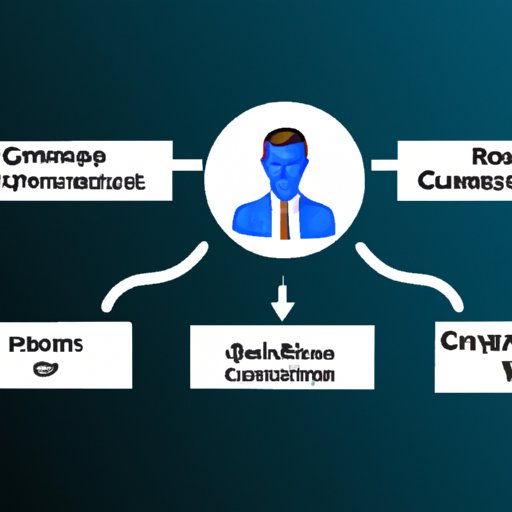Introduction
Customer Relationship Management (CRM) automation is a process of automating various tasks associated with managing customer relationships, such as collecting data, analyzing trends, and providing customer service. By leveraging the power of technology, businesses can use CRM automation to streamline processes and improve customer experience. In this article, we will explore the benefits of CRM automation, understand the basics of a CRM system, and discuss how to implement it in your business.
Exploring the Benefits of CRM Automation
CRM automation offers numerous advantages for businesses, including reducing administrative overhead, improving customer data management, and enhancing customer service. Let’s take a closer look at each of these benefits.
Reduced Administrative Overhead
CRM automation eliminates tedious manual tasks associated with managing customer relationships, allowing businesses to focus on more important activities. According to a study conducted by Aberdeen Group, businesses that implemented CRM automation saw an average reduction of 42% in their administrative costs.
Improved Customer Data Management
CRM automation also helps businesses store and organize customer data in a centralized location. This makes it easier to access customer data quickly and accurately. Moreover, automated systems can detect duplicate entries and ensure data accuracy, which is essential for making informed decisions about customers.
Enhanced Customer Service
CRM automation facilitates faster response times, which helps improve customer satisfaction. For example, automated systems can send personalized emails or messages to customers, helping businesses build better relationships with them. Additionally, automated systems can track customer behavior and provide insights into their preferences, allowing businesses to tailor their products and services accordingly.

Understanding the Basics of CRM Automation
Before implementing CRM automation, it is important to understand the basics of a CRM system. A CRM system is a software application that enables businesses to store, manage, and analyze customer data. It helps businesses track customer interactions, identify sales opportunities, and automate marketing campaigns.
What is a CRM System?
A CRM system is a comprehensive software solution that helps businesses manage customer relationships and maximize their return on investment. It includes a variety of features such as contact management, sales automation, customer service management, and marketing automation. By leveraging the power of technology, businesses can streamline their customer relationship management processes and improve customer experience.
Key Components of a CRM System
The key components of a CRM system include lead management, contact management, sales automation, customer service management, marketing automation, and reporting. Lead management helps businesses capture leads from various sources and convert them into customers. Contact management allows businesses to store customer information and track customer interactions. Sales automation helps businesses streamline the sales process and close deals faster. Customer service management enables businesses to provide timely and effective customer service. Marketing automation helps businesses create targeted campaigns and measure their performance. Finally, reporting capabilities enable businesses to generate customized reports and gain valuable insights into customer behavior.

Utilizing CRM Automation to Improve Business Efficiency
CRM automation can help businesses improve their efficiency and maximize their return on investment. Here are some ways businesses can utilize CRM automation to improve their operations.
Automating Tasks for Greater Efficiency
CRM automation enables businesses to automate mundane tasks such as data entry and customer service inquiries. This frees up employees’ time to focus on more important tasks, such as sales and marketing. Additionally, automated systems can be programmed to trigger notifications and alerts, ensuring that employees are always up-to-date on customer needs and preferences.
Streamlining Data Analysis
CRM automation also helps businesses streamline data analysis. Automated systems can collect data from various sources, analyze it, and generate actionable insights. This helps businesses make informed decisions about customers and tailor their products and services according to their needs.
Enhancing Collaboration Across Departments
CRM automation facilitates collaboration across departments by providing a centralized platform for storing and sharing customer data. This makes it easier for different departments to access customer data quickly and accurately, enabling them to work together effectively.
How To Implement CRM Automation in Your Business
Implementing CRM automation in your business requires careful planning and execution. Here are some steps you can take to ensure successful implementation.
Assessing Your Current Processes
The first step in implementing CRM automation is to assess your current processes. Evaluate your existing systems and processes to identify areas where automation can help improve efficiency. Identify any gaps in your processes and determine what changes need to be made.
Establishing Goals and Requirements
Once you have identified the areas where automation can help, establish goals and requirements for the project. Consider factors such as budget, timeline, and desired outcomes. This will help you develop a clear plan for the implementation.
Selecting the Right CRM Solution
After establishing your goals and requirements, select a CRM solution that best meets your needs. Research different solutions and compare features, pricing, and customer reviews. Select a solution that has the features you need and fits within your budget.
Training Employees
Once you have selected a CRM solution, train your employees on how to use it. Provide detailed instructions and ensure that everyone understands the features and functionality of the system. Additionally, provide ongoing support and guidance to ensure that employees remain up-to-date on the latest features and updates.

Leveraging CRM Automation for Maximum Results
To get the most out of CRM automation, businesses should focus on measuring performance, creating an action plan, and integrating new technologies. Here’s how.
Measuring Performance
Regularly measure the performance of your CRM system. Track metrics such as customer satisfaction, lead conversion rate, and sales volume to gauge the success of your automation efforts. Analyze the data to identify areas of improvement and adjust your strategy accordingly.
Creating an Action Plan
Develop an action plan to ensure that your CRM automation efforts are aligned with your business goals. Set measurable objectives and define specific tasks and timelines for achieving them. This will help you stay organized and focused on the right tasks.
Integrating New Technologies
Finally, consider integrating new technologies into your CRM system. For example, you can integrate artificial intelligence (AI) and machine learning (ML) to automate routine tasks and provide personalized customer experiences. Additionally, you can integrate social media platforms to reach more customers and engage with them in real time.
Conclusion
CRM automation is a powerful tool that can help businesses improve customer service, reduce administrative overhead, and increase business efficiency. By understanding the basics of a CRM system and utilizing automation to its full potential, businesses can maximize their return on investment and achieve greater success.
In conclusion, businesses can benefit significantly from CRM automation. It helps reduce administrative costs, improve customer data management, and enhance customer service. Additionally, businesses can use CRM automation to automate tasks, streamline data analysis, and enhance collaboration across departments. To successfully implement CRM automation, businesses should assess their current processes, establish goals and requirements, select the right CRM solution, and train employees. Finally, businesses should focus on measuring performance, creating an action plan, and integrating new technologies to leverage CRM automation for maximum results.
(Note: Is this article not meeting your expectations? Do you have knowledge or insights to share? Unlock new opportunities and expand your reach by joining our authors team. Click Registration to join us and share your expertise with our readers.)
